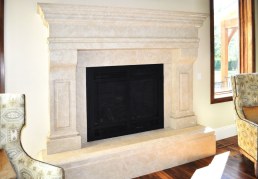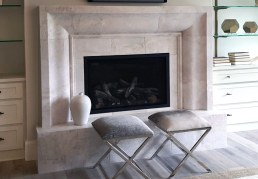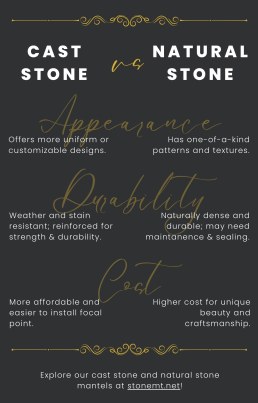The Difference Between Cast Stone and Natural Stone: Which Is Right for You?
Your fireplace mantel is more than just a decorative feature—it’s the focal point of your living space and a reflection of your style. When selecting the perfect material, the choice often comes down to cast stone or natural stone. Both options have their unique advantages, offering beauty and durability, but which one is the right fit for your home? In this guide, we’ll explore the key differences to help you make an informed decision that aligns with your vision and budget.
What Is Cast Stone?
Cast stone is a refined building material designed to simulate natural-cut stone. It is produced by blending natural aggregates, such as crushed limestone or granite, with cementitious binders and mineral pigments. This mixture is then molded and cured to create architectural stone products such as mantels that resemble natural stone in appearance and texture.


Natural Stone Mantels
Natural stone mantels are crafted from quarried stones like limestone, marble, or granite. Each piece is unique, showcasing the inherent variations in color, veining, and texture that only nature can provide. These mantels are often hand-carved by skilled artisans, resulting in one-of-a-kind architectural features.
Comparing Cast Stone and Natural Stone for Mantels
Appearance and Texture
- Cast Stone: Offers a uniform look with consistent color and texture. The manufacturing process allows for precise control over the final product’s appearance, enabling the creation of intricate designs and custom finishes.
- Natural Stone: Provides a unique, one-of-a-kind appearance. Each piece has its own patterns, veining, and color variations, adding depth and character to any structure.
Durability and Maintenance
- Cast Stone: Engineered to withstand specific environmental conditions and can be reinforced for additional strength. It is generally less porous than natural stone, making it less susceptible to staining and weather damage. However, it may lack the density and strength of natural stone.
- Natural Stone: Known for its strength and durability, natural stone can last for generations when properly maintained. Its density and natural composition make it resistant to wear and tear, though certain types may require periodic sealing to prevent staining.
Cost Considerations
- Cast Stone: Often more affordable than natural stone, especially for large-scale projects. The manufacturing process allows for more efficient production, leading to cost savings. Its lighter weight also makes it quicker and easier to install, reducing labor costs.
- Natural Stone: Renowned for being an expensive material, partly because of its desirability due to its durable properties and aesthetic value, but also because of the time, costs, and skill involved with extracting, cutting, and finishing it.

Which Is Right for Your Mantel?
Choosing between cast stone and natural stone depends on your specific needs, aesthetic preferences, and budget. If you are looking for a high-quality, one-of-a-kind look with the timeless appeal of natural materials, a natural stone mantel may be the ideal choice. However, if you want a more cost-effective option that offers design versatility and ease of installation, cast stone provides a compelling, beautiful alternative.
At Stone Mountain Castings & Design, we craft cast stone and natural stone mantels tailored to your unique vision. Our team is dedicated to helping you select the perfect material that aligns with your design goals and functional requirements.Ready to transform your fireplace with a stunning mantel? Contact us today to explore our extensive range of architectural stone products and discover the perfect centerpiece for your home.